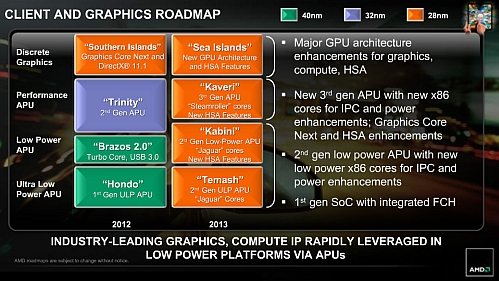During AMD's Financial Analyst Day 2012, the company took no hesitation to present its roadmap in the GPU front extending all the way into late 2013. At the very top of its Client and Graphics Roadmap depicts the 28nm Southern Islands GPU family being replaced with a new 28nm Sea Islands GPU family sometime in 2013.
AMD's current Southern Islands GPU family, based on 28nm High-K Metal Gate (HKMG) architecture from TSMC, is composed of three core GPUs - Tahiti, Pitcairn and Cape Verde. The company's flagship Radeon HD 7970, Radeon HD 7950 and eventually the dual-GPU Radeon HD 7990 are all based on Tahiti, while the upcoming Radeon HD 7870 and Radeon HD 7850 will be based on Pitcairn and the upcoming Radeon HD 7770 and Radeon HD 7750 will be based on Cape Verde.
Earlier this year, it was discovered that a former AMD MTS design enigineer leaked the name "Sea Islands" in reference to a job description on his LinkedIn profile. While rumors had surfaced regarding the accuracy of the family codename, and while Charlie from SemiAccurate didn't agree with it, AMD has now confirmed that its next-generation Radeon HD 8000 Series family will indeed be released under this codename.
At the moment, we have no information on AMD's specific GPU codenames for the 28nm Sea Islands family, other than the fact that the name "Sea Islands refers to the chain of islands on the Atlantic Coast of the United States. Of course, for those speculators out there, a quick Wikipedia search will get you a list of over 100 islands found on the Atlantic Coast. It's anybody's guess as to which codenames AMD will choose to classify its Sea Islands GPUs. Nevertheless, this is the closest roadmap we could find:
Published in
News
AMD 28nm Sea Islands official successor to Southern Islands

2nd-gen Graphics Core Next (GCN)
Over the past few months, it has become clear that AMD's recent CEO Rory Read and his new management team have been hard at work utilizing precious business hours to restructure the company from the ground up for more efficient market delivery, execution and product competitiveness. Not only do these aggressive plans manifest themselves in AMD's refocused x86-based APU and server strategies moving forward into 2013, but also in its Graphics Core Next (GCN) architectural plans for its primary GPU business.



